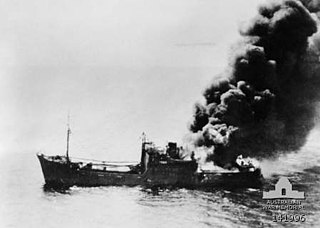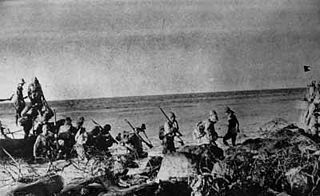
USS Gato (SS-212) was the lead ship of her class of submarine in the United States Navy. She was the first Navy ship named for the common name used for a number of species of catshark. She was commissioned only days after the declaration of war and made thirteen combat patrols during World War II. She survived the war and spent the post-war period as a training ship before being sold for scrapping in 1960.

USS Scamp (SS-277), a Gato-class submarine, was the first ship of the United States Navy to be named for the scamp grouper, a member of the family Serranidae.

The Battle of the Bismarck Sea took place in the South West Pacific Area (SWPA) during World War II when aircraft of the U.S. Fifth Air Force and the Royal Australian Air Force (RAAF) attacked a Japanese convoy carrying troops to Lae, New Guinea. Most of the Japanese task force was destroyed, and Japanese troop losses were heavy.
Gyōkū Maru (暁空丸) was a 6,854 GRT cargo ship that was laid down 6 December, 1941 as Empire Dragon by Hong Kong & Whampoa Dock Co Ltd, Hong Kong for the Ministry of War Transport (MoWT). She was seized by the Japanese on 26 December, 1941 with the fall of Hong Kong and completed as Gyōkū Maru in August, 1943, serving until September 1944 when she was torpedoed and sunk by USS Thresher in the Yellow Sea.
Mayasan Maru (摩耶山丸) was a Japanese landing craft depot ship used extensively to transport Imperial Japanese Army (IJA) troops during 1943 and 1944. After avoiding damage in seven separate submarine attacks in earlier convoys, she was sunk in the East China Sea by the submarine USS Picuda on 17 November 1944 while part of Convoy Hi-81. The sinking caused one of the highest maritime casualty counts of World War II. Some 3,536 people died.

Kembu Maru was a 953-ton transport ship of Imperial Japanese Army during World War II.

Taimei Maru was a 2,883 ton transport ship of the Imperial Japanese Army during World War II.
Sin-ai Maru, also known as Shin-ai Maru was a 3,794 ton transport ship of the Imperial Japanese Army during World War II.
SS Kyokusei Maru (Kanji:旭盛丸) was a 3,794 GRT transport ship of the Imperial Japanese Army during World War II.
Oigawa Maru (大井川丸) was a 6,494 GRT transport ship of the Imperial Japanese Army during World War II.
Sakito Maru was a 7,126-ton Japanese troop transport that operated during World War II. She was sunk on 1 March 1944 with great loss of life.

The Nojima Maru, also known as Noshima Maru or Nozima Maru, was an 8,215 ton coal ship, also used as troop transport ship by the Imperial Japanese Army (IJA) during World War II.
SS Saarland was a 6,870 ton German passenger ship, which was sold to Japan in 1940, renamed Teiyo Maru and used as troop transport ship by the Imperial Japanese Army (IJA) during World War II. It sank during the Battle of the Bismarck Sea with great loss of life.

Kaimei Maru was a Japanese troop transport ship operated by the Imperial Japanese Army during World War II which was sunk off Honshu on 4 September 1942 by the American submarine USS Guardfish. The ship was a British WWI Type B military cargo ship built by the Hong Kong and Whampoa Dock Company.
Yamafuku Maru was an auxiliary transport ship of the Imperial Japanese Navy during World War II. She served primarily as a troop transport and cargo ship during the war.
Hokkai Maru was a Kinai Maru-class auxiliary transport of the Imperial Japanese Navy during World War II. She participated in the Japanese occupation of British Borneo and was part of ill-fated convoy HI-71.
Fukuei Maru No. 15 was a Japanese cargo ship that was requisitioned by the Imperial Japanese Navy during World War II and converted into an auxiliary netlayer.
Shonan Maru No. 17 was a Japanese fishing vessel that was requisitioned by the Imperial Japanese Navy during World War II and converted into an auxiliary subchaser.






